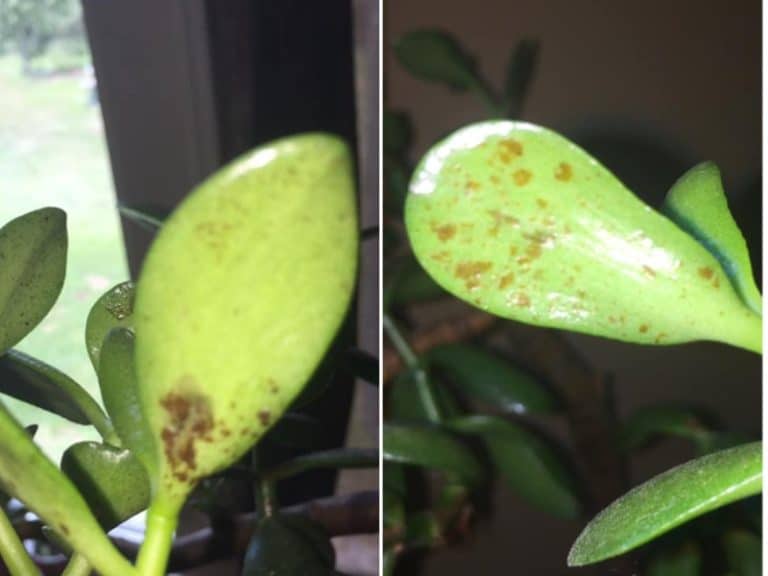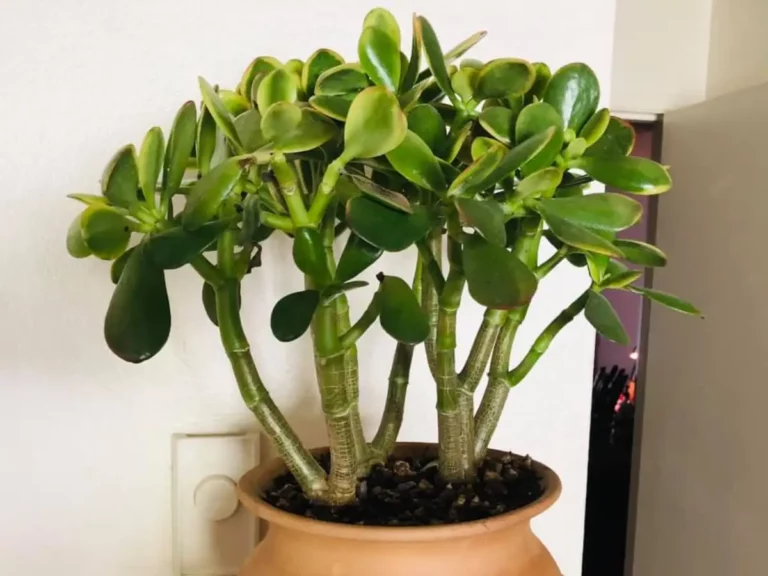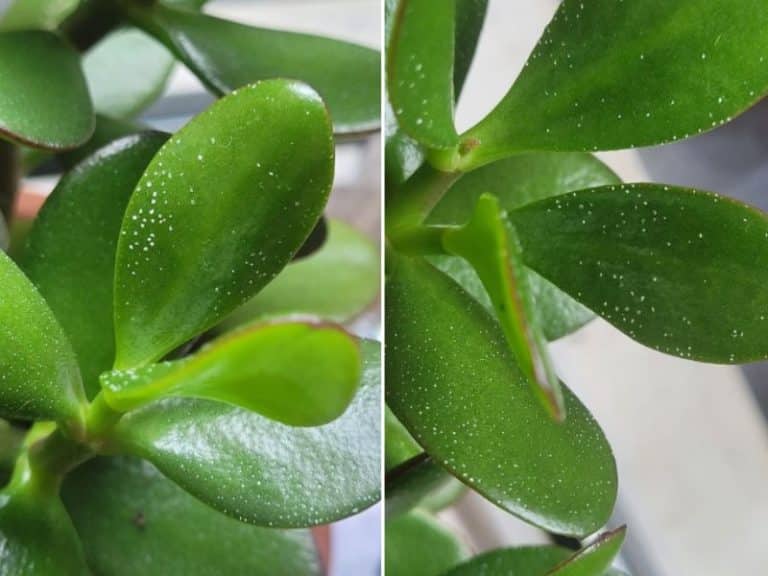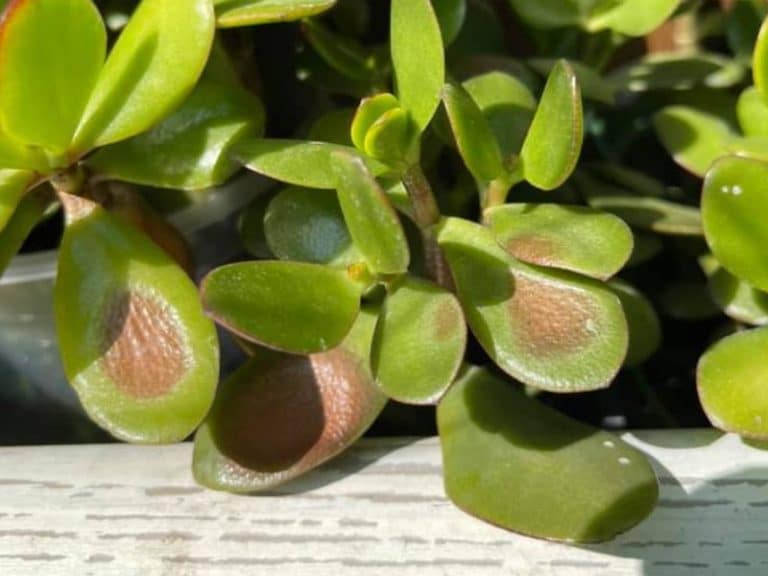Jade Plant Care – Water, Light, Problems & More
The jade plant (Crassula ovata) is one of my favorite low-maintenance indoor plants because its growth rate is quite slow, so I don’t have to do much pruning and repotting. The plant will produce rich foliage and beautiful blooms if you provide it with enough light, water, and an all-purpose soil mix mixed with perlite.
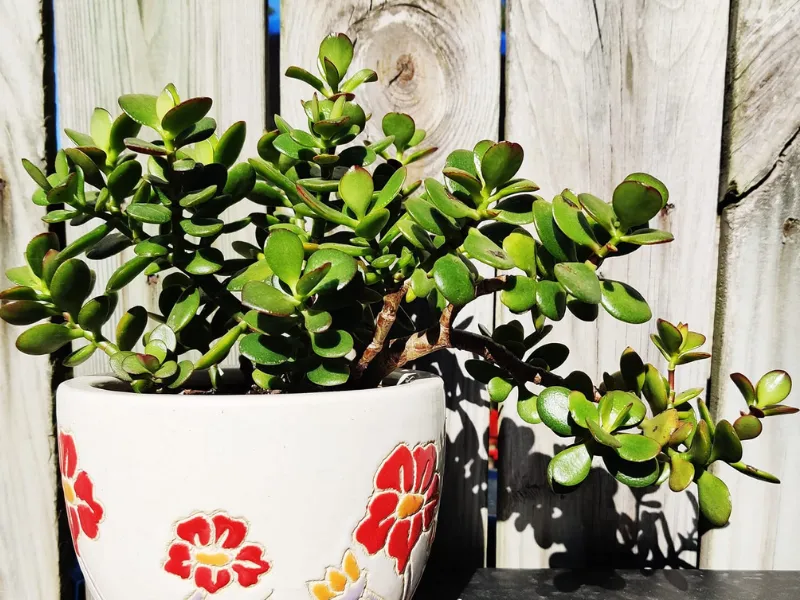
Here’s the jade plant profile and care guide:
| Names | Jade Plant, Crassula ovata, Friendship tree, Money plant |
| Sunlight | 4-6 hours of bright indirect sunlight |
| Water | Once every 2 to 3 weeks |
| Temperature | 55-75°F (daytime); 50-55°F (nighttime) |
| Humidity | 30%-50% relative humidity |
| Soil pH | Slightly acidic: 6.0-6.5 |
| Growing zones | USDA zones 10 and 11 |
| Size | 5-6 feet (when grown indoors) |
You can propagate jade plants from seed or plant cuttings. You can keep the jade plant in one pot for a while, provided the soil is well-draining with a neutral pH in full sunlight.
The key to keeping your jade plant green, succulent, and alive for long is never to let it dry out or stay in waterlogged soil. You also get bonus growth years if you keep it from chilly weather.
Contents:
Care requirements
You must consider factors such as sunlight, water, and humidity requirements if you’re keeping a jade indoors or outdoors. You must also provide the preferred soil type, pH, and temperature conditions.
Sunlight requirements for jade plants
How much light does a jade plant need?

Jade plants need 4 to 6 hours of bright sunlight when growing indoors. Young plants may not withstand full sun, so it is best to place them in a spot where they will receive bright indirect sunlight, such as a south-facing or west-facing window.
When growing outdoors, mature jade plants can withstand full sunlight. However, if the sun gets too hot, the jade’s leaves will be sunburned and can develop large brown patches as a result.
Mature Crassula ovata plants will survive in indirect sunlight but will barely thrive. I find that those growing in shaded conditions become leggy and top-heavy. On the other hand, young jade plants should not be exposed to direct sunlight. They’d do best in partial sun, or mild indoor grow lights.
Pro tip: Without sufficient sunlight, your jade plants may not bloom at all. I’ve had a 9-year-old jade plant that never blossomed until I moved it to a spot where it started receiving enough sunlight.
Watering
A jade plant prefers to be watered when the top 1-2 inches of the potting soil is dry. When grown indoors, you can water the plant once every 2 to 3 weeks, but avoid following a watering schedule because it can lead to overwatering and root rot.
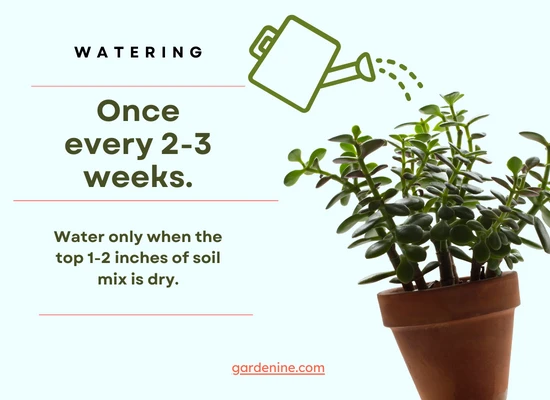
Try to keep the soil moist but not soggy. You’ll know the plant needs water when leaves start to wrinkle, drop, or develop brown spots.
The rule of thumb is to water more frequently in the growing season or summer. Water at least after every 1-3 weeks depending on the weather.
As a succulent, a jade plant requires little water to survive because it stores water in its stems and leaves, allowing it to go for 14 days or even more without watering.
Pro tip:To determine whether your jade plant is ready to be watered again, insert a finger or a stick into the soil. If the soil is still damp and soil particles cling to your finger or the stick, wait a few more days until the soil dries out.
You want to avoid overwatering your jade plant because the leaves will become mushy and squishy. When sitting in a water-logged pot, the plant is at risk of root rot disease.
Signs of an overwatered jade plant include soft leaves and stems, rotting roots, and yellowing, droopy leaves. Leaves may also develop brown spots due to root rot disease. To save and revive the jade plant, remove the most affected roots and repot the crassula in well-draining soil.
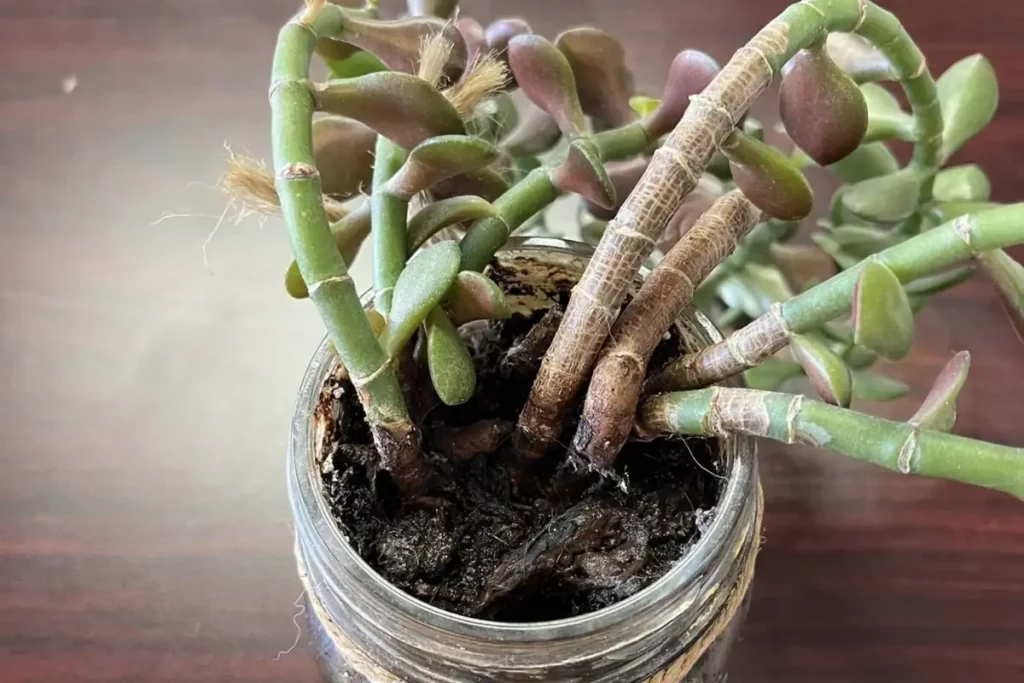
Fixing overwatered jade:
- Remove the plant from the pot to give it better air circulation.
- Cut the rotten roots with pruning shears sterilized in alcohol. Also, trim the infected soft and yellow leaves.
- Repot the jade plant in a well-draining new soil that has already been moistened.
- Place the repotted plant in a spot with adequate light.
From here on, only water when the soil is dry to avoid overwatering.
The signs of waterlogging and underwatering can overlap. Here’s how to tell the difference:
| Under Watered jade | Overwatered jade |
| The potting soil is dry. | The potting soil remains soggy and waterlogged. |
| The leaves become wrinkled and shriveled. | The dying leaves become soft and squishy. |
| The brown parts of the leaves are dry and crispy. | The brown spots on the leaves are swollen and blister-like. |
| The roots become hard and brittle. | The roots are rotten and mushy. |
| The stems become hard and wrinkly. | The stems become soft and mushy. |
Correctly watering houseplants goes a long way in preventing brown spots on the foliage, leaf yellowing, root rot disease, and most bacterial diseases.
Humidity
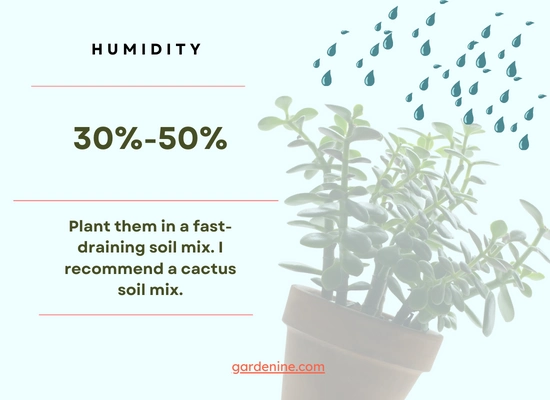
Crassula ovata flourishes in low relative humidity between 30% and 50%. To provide such dry air conditions, ensure your jade plant is placed in a room with proper ventilation and it isn’t grouped closely with other houseplants that could humidify it.
Air conditioners and heaters are great for lowering indoor humidity.
Soil pH
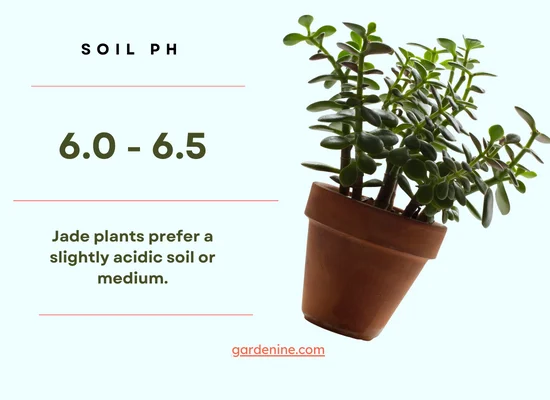
Jade plants flourish in slightly acidic soil with a pH range of 6.0 to 6.5. However, can still survive in mildly alkaline soil conditions but you’ll notice signs of struggle due to nutrient deficiencies as the alkalinity increases.
Add peat moss to the soil mix if you have a neutral or slightly alkaline soil mix to acidify it for growing a jade plant. Coconut fiber also does a great job of lowering soil pH.
Soil type
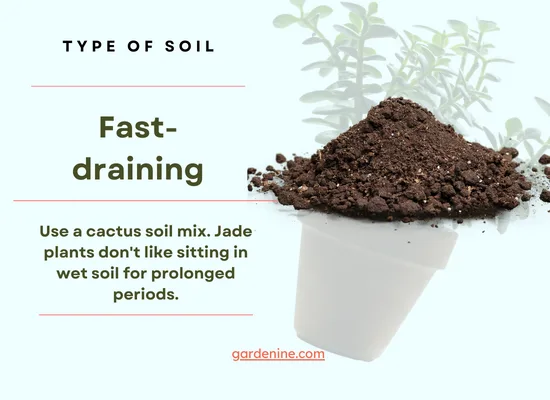
The jade plant thrives in fast-draining soil. Use soil mix containing sand, pebbles, and perlite for excellent drainage. Soil containing nutrients such as phosphorus and potassium is also great for the succulent plant.
A potting soil mix laden with organic matter such as peat moss, bat guano, bone meal, and worm castings is preferable.
Growing zones
The jade plant grows best in USDA plant hardiness zones 10-11. There is no frost during the cold season in these regions. The jade plant can be placed outdoors in these zones where the winter temperature range is typically 30-50 degrees Fahrenheit.
Here’s a brief overview of USDA hardiness zones 10 and 11:
- Zone 10 includes the warmer equatorial regions of North America, including Hawaii, Southern California, and Southern Florida.
- Zone 11 comprises Hawaii and the Florida Keys.
Temperature

Crassula ovata thrives in daytime temperatures ranging from 55-75 degrees Fahrenheit. Meanwhile, optimal nighttime temperatures for this houseplant fall between 50-55 degrees Fahrenheit. Therefore, if you wish to move your jade plant outdoors during the summer, ensure you bring it back in when nighttime temperatures drop below 50 degrees Fahrenheit.
Jade plants are vulnerable to cold/frost damage and should not be kept next to drafty windows and doorways. Failure to do so, especially in the winter months, will likely cause the leaves to drop.
The table below summarizes the care requirements for the jade plant.
Mature size
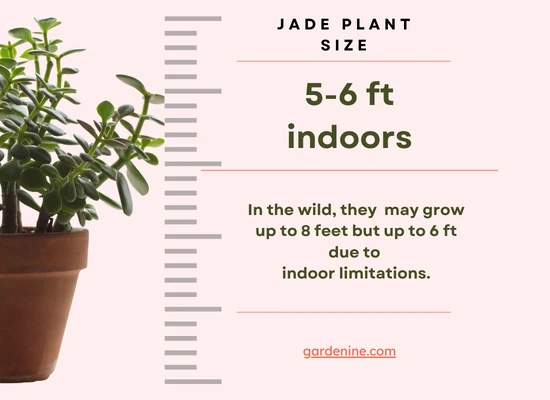
Jade plants can reach heights of up to 8 feet in the wild. However, this plant typically tops off at 5-6 feet tall when grown indoors. The jade plant is a slow grower, with annual height increments of no more than 2-3 inches.
Most of the active growing takes place during the spring and summer. In the winter, the jade plant growth rate slows down significantly as the plant enters dormancy.
Potting and repotting
Follow the steps detailed below to plant a jade plant inside a pot correctly.
- Choose a planting pot with a drainage hole whose width doesn’t exceed that of the root ball by more than 2 inches.
- Fill 1/3 of the pot with a soil potting mix specially formulated for succulents like jade plants. Such a mix ensures good drainage and nourishment to the plant.
- Plant the jade plant, ensuring the top of the root ball is about one inch below the pot’s rim. Doing so leaves enough room for irrigation.
- Apply more potting soil mix around the root ball and water the jade plant. Place a saucer underneath to allow proper drainage before transferring your newly-potted plant indoors.
Jade plants are slow growers and don’t need to be repotted as often as most common houseplants. Moreover, keeping the jade plant root-bound helps to keep it at a more manageable size.
Ideally, you want to repot your Crassula ovata only once every 2-3 years. The best time of the year to repot jade plant is in early spring, before the onset of the growing season.
After replanting, don’t water the succulent for at least seven days. Also, don’t fertilize for at least one month after repotting to avoid killing the fresh roots.
Note: Keeping a jade plant root-bound in a small pot promotes blooming. However, repotting encourages growth.
When to prune
To spur new growth and boost plant health in jade plants, it’s vital to cut back overgrown or leggy branches and drooping branches. Jade plants should only be pruned once they’ve passed one year. Pruning jade plants younger than one year isn’t recommended, as the roots and trunk are still developing. Pruning too early causes stunted growth.
The money plant is a top-heavy houseplant; weaker branches droop when they can no longer support the weight of the water-holding leaves. Pruning such branches encourages the growth of thicker, stronger branches that can support the weight of the leaves and lead to taller, wider growth.
The best time of the year to prune weak stems on jade plants is in the spring or early summer when they’re actively growing. Pruning at this time of the season ensures new growth sprouts faster. Additionally, the temperature and warmth in the spring and summer season ensures faster plant recovery from pruning.
Note: You can prune your jade plant at any other time of the year, but the recovery won’t be as fast.
Toxicity to humans, cats and dogs
The jade plant is only mildly poisonous to humans if ingested. However, it’s highly toxic to dogs, cats, and other dogs. Place it on a high platform if you have pets that like to nibble on the houseplants.
Jade plant common diseases
Jade plant often suffer from diseases including bacterial soft rot, powdery mildew, and sooty mold.
Bacterial soft rot
This bacterial disease is caused by a pathogen called Erwinia. It causes the interior tissue of the jade plant to become soft and soggy. Also, it causes the collapse of the stem and branches. Moreover, the soft leaves turn brown, and the plant develops an unpleasant odor.
The best treatment for bacterial soft rot is to cut off affected shoots to revive the plant.
Powdery mildew
This fungal disease is caused by a pathogen called Sphaerotheca that causes the appearance of white powdery film sections on the jade plant’s foliage and withering of the leaves. Overwatered jade plants or jade plants exposed to excessive humidity are more susceptible to powdery mildew.
You can control powdery mildew by applying a fungicide such as potassium bicarbonate, Bacillus subtilis, or neem oil. You can also use a blend of baking soda and vinegar.
Sooty mold
This disease develops on the honeydew formed on the leaves whenever mealybugs or aphids invade jade plants. Sooty mold looks like soot and diminishes the plant’s ornamental appeal.
Wipe the plant’s leaves with a wet towel to control sooty mold.
Jade plant common pests
The most common Crassula ovata pests include mealybugs, scales, and spider mites.
Mealybugs
Mealybugs are tiny, white, fluffy pests that hide underneath the leaves and branches and suck the sap from the plant. They also form honeydew that reels in other pests.
You can get rid of these pests by spraying the plant with a stream of water or wiping them off the plant using a cotton swab dipped in 70% isopropyl alcohol.
For more severe infestations, use a systemic chemical pesticide such as dinotefuran.
Scales
Scales are tiny black or brown insects that stick to the lower side of the leaves and suck the sap from the leaves, attracting bacterial infection.
These pests are largely pesticide-resistant due to their hard outer shell and are best removed manually.
Spider mites
Spider mites are tiny insects that suck the sap out of jade plant leaves, causing the plant to lose its vigor. The webbing this pest forms on the leaves and branches also diminishes the plant’s aesthetic appeal.
Spider mites can be easily controlled using chemical treatments.
FAQ
Are jade plants easy to care for?
Jade plants are easy-to-care-for succulents that can tolerate a wide range of conditions. They’ll thrive with minimal attention if planted in a well-draining potting mix, watered sparingly, and placed in bright, indirect light.
What are the common jade plant problems?
Jade plants are susceptible to legginess, overwatering, underwatering, leaf drop, and brown spots on leaves. These problems can be avoided by providing the plant with the right amount of light, water, and fertilizer. Additionally, using a well-draining potting mix, repotting every 2-3 years, and inspecting the plant regularly for pests and diseases can help prevent problems.
References
- Gary W. Moorman, Pennsylvania State University (PSU): Crassula (Jade Plant) Diseases
- CABI.org- Invasive Species Compendium: Crassula ovata (jade plant)


